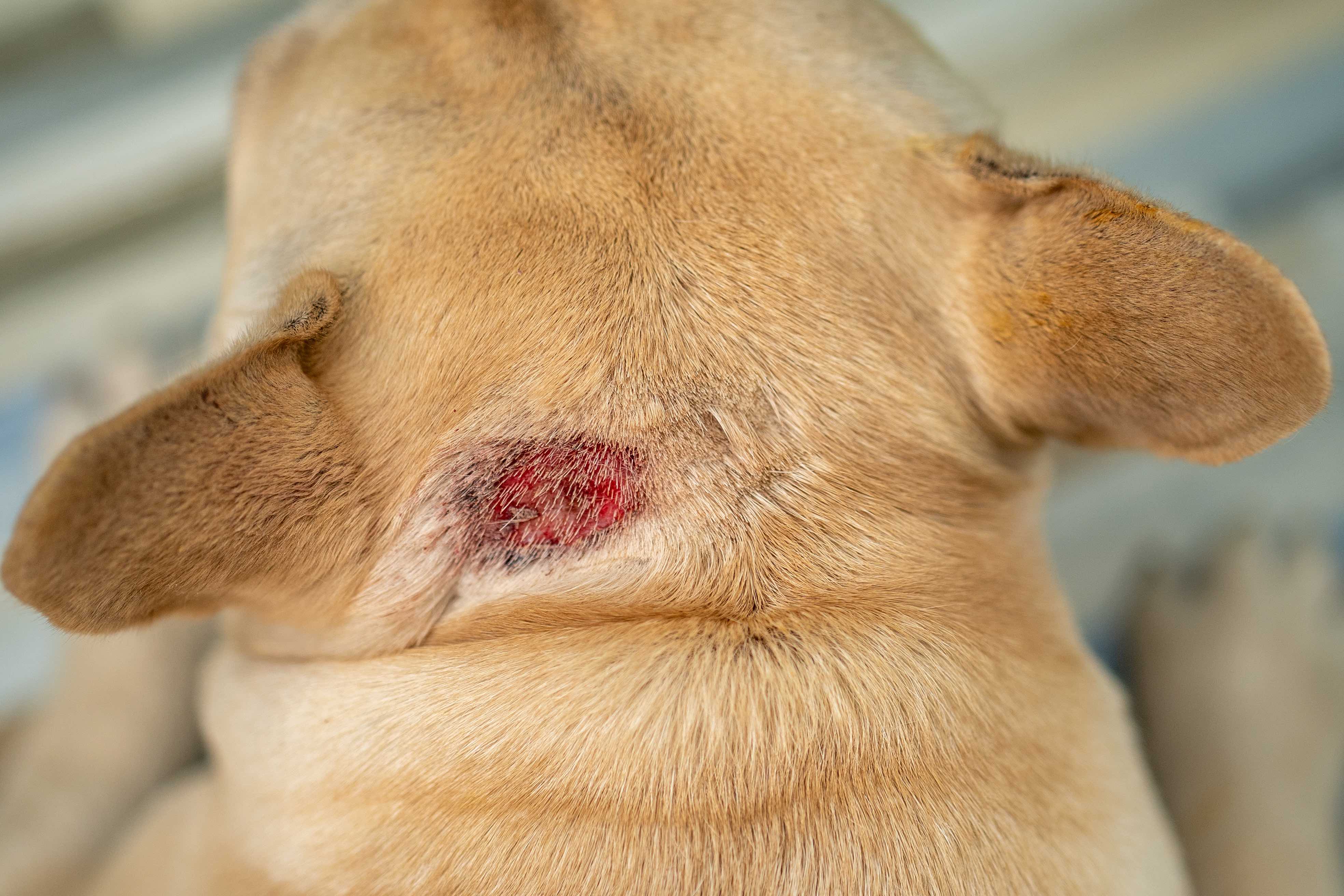How To Treat Hot Spots on Dogs
Out of all the possible skin conditions in dogs, hot spots are among the most common. Hot spots can have different underlying causes and treatments based on severity.
Here’s everything you need to know about hot spots on dogs—from what they are and what causes them to how to treat and prevent them.
Health Tools
Not sure whether to see a vet?
What Are Hot Spots on Dogs?
Hot spots, also known as acute moist dermatitis, are painful red areas of infected skin that appear to be irritated and are sometimes raised.
Hot spots on dogs can occur anywhere on the body, but they are commonly found on the face, neck, limbs, or hips. The size and appearance of the lesions can vary slightly in each location, but most will look similar regardless of where they are.
These spots can appear quickly, usually with some degree of hair loss, and become much larger in a matter of days.
Hot spots on dogs can be relatively minor and heal quickly. But they do have the potential to cause more serious issues, such as widespread infection or deeper skin ulcerations.
What Do Dog Hot Spots Look Like?

The actual hot spot lesion can range in size. But hot spots are usually red, inflamed, and raw, and they may bleed intermittently.
The area will become moist and painful. It typically spreads due to licking, chewing, and/or scratching.
Hot spots on dogs will usually look different than other skin conditions, such as ringworm or mange, because the skin is very moist and inflamed. For example, ringworm (as well as some parasitic skin infections) will have associated hair loss but are usually drier in appearance compared to hot spots.
What Causes Hot Spots on Dogs?
Certain breeds are predisposed to skin conditions, including hot spots. Commonly affected breeds include Golden Retrievers, English Bulldogs, and German Shepherds.
Most hot spots on dogs are caused by an underlying condition that either causes itchiness, excessive licking, or excessive moisture. The most common conditions include:
-
Allergies (flea allergy, food allergy, or seasonal allergies)
-
Excessive moisture from swimming
-
Excessive licking due to boredom
-
Poor grooming
-
Anal gland inflammation
How to Treat a Hot Spot on a Dog
While some hot spots can be treated at home, the underlying cause should always be identified, if possible, to prevent more hot spots from occurring.
Hot spots on dogs can occur anywhere on the body, but they are commonly found on the face, neck, limbs, or hips.
To determine the underlying cause (especially for large or overly infected hot spots on dogs), a veterinary exam is necessary. It’s even more urgent if the affected area is:
-
Increasing in size
-
Consistently bleeding
-
Displaying colored discharge
You should also seek veterinary attention sooner if you cannot keep your pet from licking or scratching at the hot spot.
What Will the Vet Do to Treat Hot Spots?
Depending on the hot spot’s severity, most veterinarians will treat the area with a combination of oral antibiotics, anti-itch medication, and a recovery cone. The area may be clipped and cleaned with antiseptic.
Additional medications (such as flea prevention or allergy medication) may be necessary to treat the underlying cause. By getting your pet veterinary care as soon as possible, you can prevent further infection.
Home Remedies for Hot Spots on Dogs
If you aren’t able to get to the vet right away, there are a few things you can do at home to help heal hot spots before your appointment.
Human medications such as Neosporin, hydrocortisone, and Vaseline should NOT be used. Topical creams and ointments tend to cause dogs to lick the area even more, so they should be avoided if possible.
Follow these steps to promote healing of the hot spot:
-
Trim the area around the hot spot with dog hair clippers (not scissors, which make it easy to accidentally cut your pet’s skin). This allows the affected area to get some air and prevent excess moisture from slowing down the healing process.
-
Clean the skin with a mild, water-based antiseptic spray or wipe (like Douxo Chlorhexidine 3% PS pads) or an antibacterial shampoo.
-
Apply a veterinary-recommended hot spot treatment spray that is safe if ingested. One example is Vetericyn Plus Antimicrobial Pet Hot Spot Spray.
-
Place a recovery cone on your dog to help keep them from biting, licking, or scratching the hot spot.
-
Monitor the area for improvement and signs of healing (decreased redness, less moisture, smaller lesion size).
-
Contact your veterinarian for an exam to treat the underlying issue, and notify them if the area is not healing or is getting worse.
How to Prevent Hot Spots on Dogs
The key to preventing hot spots in dogs is determining the underlying cause. Your veterinarian can help you with this. But in general, it is important to:
-
Keep your dog current on flea prevention
-
Groom them regularly (especially after swimming)
-
Prevent ear infections by using maintenance ear cleansers
-
Treat allergies, if needed
-
In some dogs, preventing boredom with interactive toys can help decrease excess licking behaviors
Although it’s difficult to completely prevent hot spots, these tips can help significantly reduce the risk of recurrent skin problems in dogs.
Featured Image: iStock.com/apomares
Help us make PetMD better
Was this article helpful?
